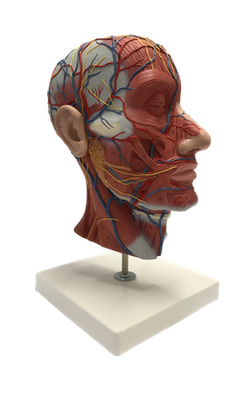Main Model

Muscles : 24a Epicranial aponeurosis

Scalp
The scalp consists of skin (normally hair bearing) and subcutaneous tissue that cover the neurocranium from the superior nuchal lines on the occipital bone to the supra-orbital margins of the frontal bone. Laterally, the scalp extends over the temporal fascia to the zygomatic arches.
The scalp is composed of five layers, the first three of which are connected intimately and move as a unit (e.g., when wrinkling the forehead and moving the scalp). Each letter in the word scalp serves as a memory key for one of its five layers:
1. Skin: thin, except in the occipital region, contains many sweat and sebaceous glands and hair follicles. It has an abundant arterial supply and good venous and lymphatic drainage.
2. Connective tissue: forms the thick, dense, richly vascularized subcutaneous layer that is well supplied with cutaneous nerves.
3. Aponeurosis (epicranial aponeurosis): the broad, strong, tendinous sheet that covers the calvaria and serves as the attachment for muscle bellies converging from the forehead and occiput (occipitofrontalis muscle) and from the temporal bones on each side (temporoparietalis and superior auricular muscles). Collectively, these structures constitute the musculo-aponeurotic epicranius. The frontal belly of the occipitofrontalis pulls the scalp anteriorly, wrinkles the forehead, and elevates the eyebrows; the occipital belly of the occipitofrontalis pulls the scalp posteriorly, smoothing the skin of the forehead. The superior auricular muscle (actually a specialized posterior part of the temporoparietalis) elevates the auricle of the external ear. All parts of the epicranius (muscle and aponeurosis) are innervated by the facial nerve.
4. Loose areolar tissue: a sponge-like layer including potential spaces that may distend with fluid as a result of injury or infection. This layer allows free movement of the scalp proper (the first three layers - skin, connective tissue, and epicranial aponeurosis) over the underlying calvaria.
5. Pericranium: a dense layer of connective tissue that forms the external periosteum of the neurocranium. It is firmly attached but can be stripped fairly easily from the crania of living persons, except where the pericranium is continuous with the fibrous tissue in the cranial sutures.